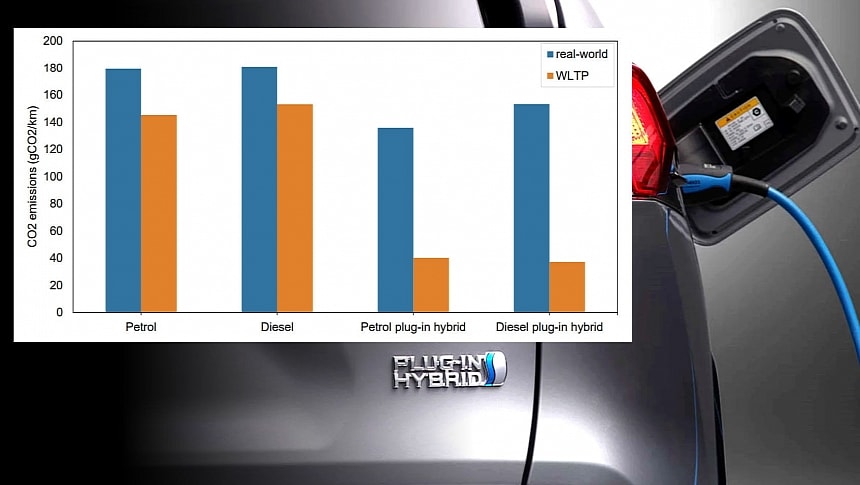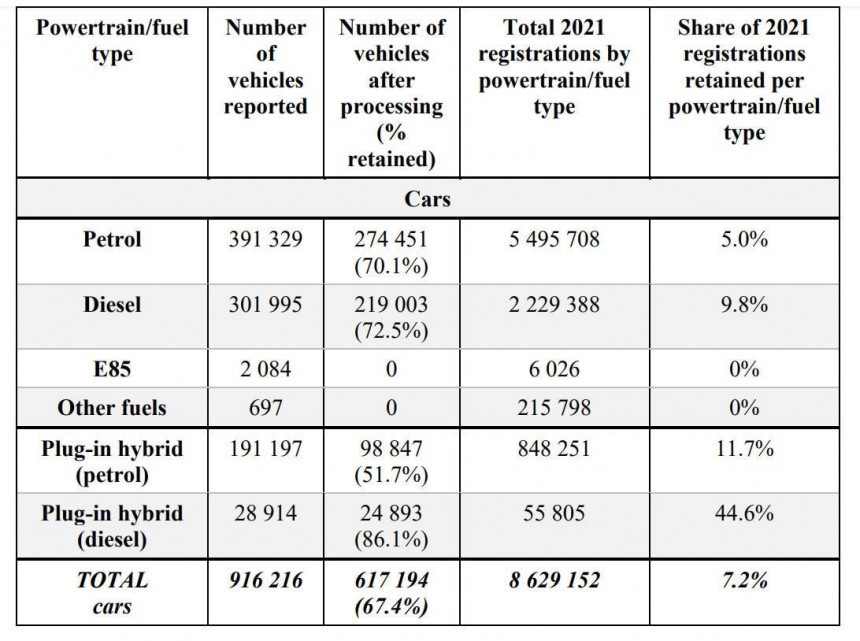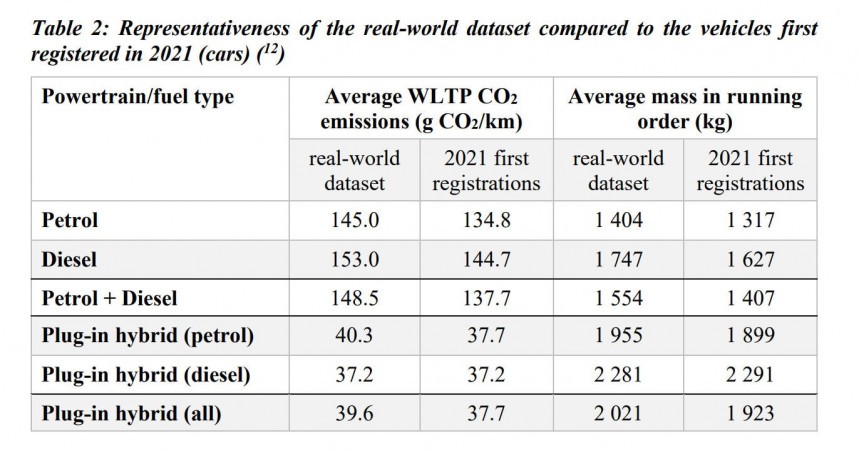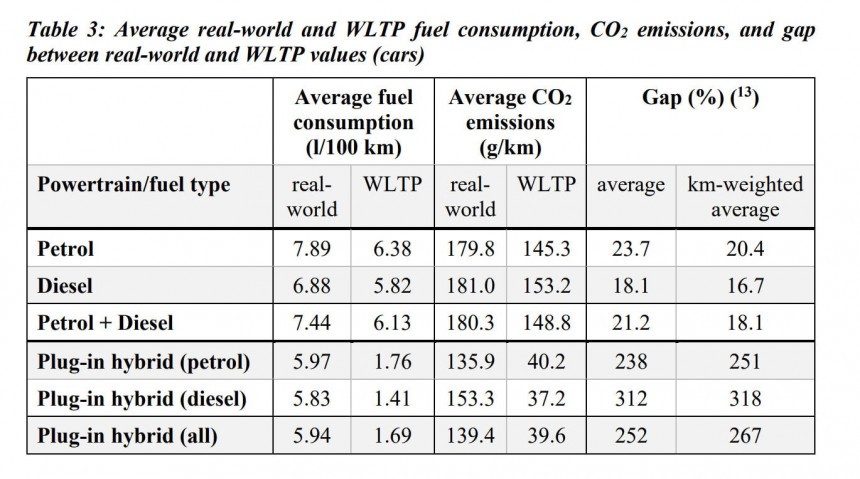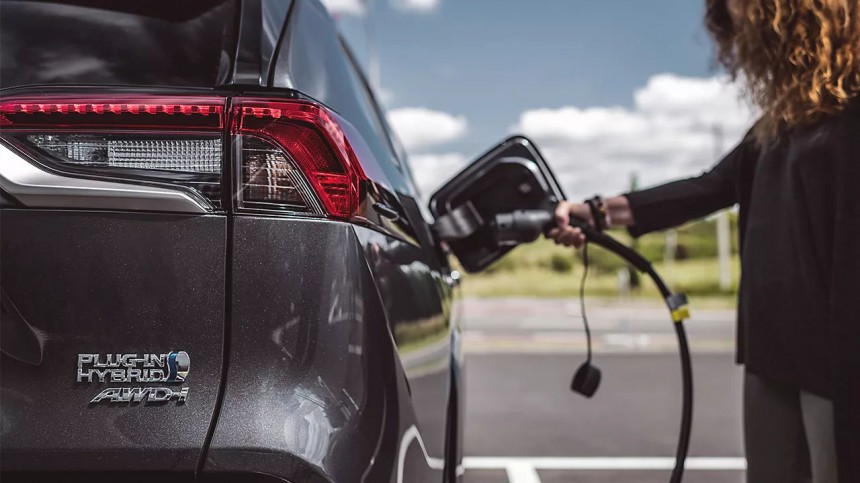It was darn time for the authorities to conduct real-world measurements on the actual consumption and emissions of the so-called "electrified cars" that also use an internal combustion engine. I really hope the popular wisdom will finally stop considering the plug-in hybrids just another breed of electric cars.
"Better later than never" seems to be the motto for the first European Commission report on real-world data regarding the CO2 emissions of new passenger cars and vans. Why is that? As you know, in 2017, the old NEDC (New European Driving Cycle), last updated in 1997, was replaced with the WLTP (Worldwide Harmonized Light-Duty Vehicles Test Procedure).
This set of new procedures was meant to represent real-world driving conditions better. Of course, this change was largely due to the 2015 Dieselgate scandal, but, while it's considered more drastic than NEDC, the WLTP has its loopholes. This translates into some CO2 emissions gap favoring carmakers and jeopardizing the EU goal of reaching climate neutrality by 2050.
The main issue in the Dieselgate scandal was a software tweak allowing the diesel engine to work in different parameters when the car was subjected to lab tests. That resulted in big differences between lab results and real-world driving, especially for NOx emissions, which were sometimes tens of times lower in lab tests.
Of course, over time, almost all carmakers were caught cheating and using these software tweaks to fool homologation tests and put on the market dirtier ICE cars than advertised. The new fuel consumption monitoring devices are not faultless, and I suspect some loopholes allow for tweaking their data.
But the risks are much higher for carmakers, so I also suspect the measurements to much better reflect real-world emissions and pollutants from cars using internal combustion engines and oil-based fuels.
After all, these real-world data must be collected by both carmakers and EU members' authorities and then reported to the EEA (European Environment Agency). If serious discrepancies occur, you can bet an "ICEgate" will once again flood headlines. I doubt the European car industry can risk another image blow in its difficult transition to electromobility.
Not very encouraging, but hey, it was the first year of such a large-scale procedure. Besides, processing data from one million vehicles sounds like a good starting point, right? Well, there's a caveat here: in the end, after removing all the "unrepresentative data, inconsistent data, outliers, and vehicles out-of-scope," there were only two-thirds of OBFCM devices to be considered.
In short, EU experts analyzed data on around 620,000 vehicles, representing only 6.3% of the total first registered vehicles in 2021. The report also points out that "only a small number of manufacturers reported data from a significant share of their vehicles registered in 2021." I wonder why car manufacturers were soreticent lazy.
Back to the numbers, the 617,194 cars providing real-world datasets represented 7.2% of all the passenger cars first registered in 2021. This percentage looks small, but actually, it's pretty consistent with general statistical rules. This means the report's findings are most likely the basis for near-future laws and taxes regarding ICE cars.
Most cars fitted with OBFCM devices were petrol and diesel (around 693,000 units), but there were also enough plug-in hybrids (220,000 units). After filtering invalid data, experts retained around 70% of the petrol and diesel cars and none of the ICE cars using E85 and other fuels, which probably were too few.
Oddly, almost half of the more than 190,000 petrol plug-in hybrid data were dismissed, while 80% of the 29,000 diesel plug-in hybrid data were considered valid. Unfortunately, there's no explanation for this situation, so I hope the next report will be more accurate regarding the plug-in powertrains.
"This may bias results," as the report's authors mention, but still, this is a good starting point for a near future change of taxation system. Because, you know, measuring the consumption and emissions of vehicles will tremendously impact the car market and ultimately will give us a clear picture of the actual road transport sector's contribution to overall pollution.
Today, the assumption is that "Road transport is responsible for about one-fifth of the European Union's (EU) greenhouse gas emissions. Within road transport emissions, light-duty vehicles (passenger cars and light commercial vehicles) are responsible for around 70% of the total."
Well, things might dramatically change in the light of new findings. The average real-world gap for ICE cars is around 20%, translating to a 30 g CO2/km surplus. Hat to tip for WLTP because, in the old NEDC procedures, the gap would often be double!
Remember that carmakers must currently comply with a 95 g CO2/km limit for the cars they sell in a year. The carmakers face stinging penalties if the theoretical average emissions pass that limit. The report shows us that cars actually emit, on average, a third more CO2 than that limit. This is an issue politicians will have to deal with after this year's historical elections…
But frankly, it's no surprise that internal combustion engine cars spew more emissions and pollutants in the real world than carmakers state. The real surprise will come for those who still believe that plug-in hybrid cars are not that different from pure battery electric cars. Partly, because of the PHEV (plug-in hybrid electric vehicle) monicker.
According to this report, the average gap for plug-in hybrids is around 250%. That's not a typo! It's simply exposing a cynical scheme by which carmakers largely misled the public into thinking plug-in hybrids really are the silver bullet to tackle transportation pollution.
For instance, the average WLTP consumption value for the plug-in hybrids here is 1.69 l/100 km. It's really amazing how people blindly embrace this value as absolute truth, ignoring it's only valid for the FIRST one hundred kilometers, under the assumption that the battery is FULLY CHARGED. As always, the devil's in the details.
My question for the policymakers is simple: why did you allow this "truth by omission" to be showcased as THE ONLY viable metric regarding a plug-in hybrid car consumption value? I don't want to get into conspiracy theories, but I find this a good case for prosecutors to investigate carmakers' lobbies and political corruption.
Meanwhile, the report findings show that the average real-world consumption is close to 6 l/100km, which is 3.5 more than the WLTP official and misleading value. Consequently, the theoretical average WLTP CO2 emission level of 39.6 g/km actually translates into almost 140 g/km in real-world driving. Again, 3.5-fold more.
What's more striking is the opposite image compared to ICE cars: while diesel cars tend to have a slightly lower gap than gasoline cars (18.1% versus 23.7%), diesel plug-in hybrids have a much higher gap than petrol plug-in hybrids (318% versus 251%). It's simple engineering: the diesel engine is much more inefficient in frequent start-stop usage than the gasoline engine.
The marketing emphasizes that a plug-in hybrid combines the best of the two worlds: you can drive zero-emission because it's an EV; you can travel long journeys without the hassle of charging and losing time because it's an ICEV; at the same time, it's more economical than an ICEV because it's a hybrid.
The only thing for this "too-good-to-be-true" scenario to work is for you to be a responsible person and use the car mostly as an EV. Because of the much lower capacity of a plug-in hybrid's battery, the range you get in the EV mode is much lower than a similar-priced EV. Consequently, you need to charge the plug-in hybrid more often.
But, hey, why bother? After all, you can rely on the ol’ good internal combustion engine when the battery is depleted. The report simply underlines what many others, including me, have warned throughout the years: plug-in hybrid cars customers don't feel compelled to charge the battery.
Add to this Toyota's moronic ads according to whom a hybrid is a self-charging electric vehicle (as if the ICE doesn't exist whatsoever!), as well as the high price tag aiming at a certain medium- and high-income public (which usually doesn't care too much about pollution), and the picture is strikingly clear: a car that is much more used as a hybrid than an EV.
I'm eager to see the next reports, which will most likely use a wider range of data from a higher number of cars. They should be the definitive answer to the subversive question, "Do we really have to phase out internal combustion engines?" which only postpones the inevitable.
Oh, and please do me a favor: stop calling the plug-in hybrids "electric vehicles." They're not such a thing, even if you're trying to use them solely in EV mode. I guarantee that, sooner or later, you'll get tired, and you'll use them simply as hybrids. Because this is what they are: expensive hybrids falsely pretending to do an EV's job.
This set of new procedures was meant to represent real-world driving conditions better. Of course, this change was largely due to the 2015 Dieselgate scandal, but, while it's considered more drastic than NEDC, the WLTP has its loopholes. This translates into some CO2 emissions gap favoring carmakers and jeopardizing the EU goal of reaching climate neutrality by 2050.
From "cheating devices" to "transparency devices"
Did you know that in 2021 came into effect another rule? That is, new cars registered from 2021 and new vans registered from 2022 must be equipped with OBFCM (on-board fuel consumption monitoring) devices. That's right; it's almost similar to Tesla collecting over-the-air data from the cars it sells.The main issue in the Dieselgate scandal was a software tweak allowing the diesel engine to work in different parameters when the car was subjected to lab tests. That resulted in big differences between lab results and real-world driving, especially for NOx emissions, which were sometimes tens of times lower in lab tests.
Of course, over time, almost all carmakers were caught cheating and using these software tweaks to fool homologation tests and put on the market dirtier ICE cars than advertised. The new fuel consumption monitoring devices are not faultless, and I suspect some loopholes allow for tweaking their data.
After all, these real-world data must be collected by both carmakers and EU members' authorities and then reported to the EEA (European Environment Agency). If serious discrepancies occur, you can bet an "ICEgate" will once again flood headlines. I doubt the European car industry can risk another image blow in its difficult transition to electromobility.
Just how many monitoring devices were actually the basis for this report?
In 2021, almost ten million vehicles were registered in Europe. More precisely, 9,821,479 passenger cars and light-duty vans were registered in the 27 EU member states, in Norway and Iceland. The OBFCM devices were used by only 988,231 vehicles – 10.6% of the passenger cars and 1% of light-duty vans first registered in 2021.Not very encouraging, but hey, it was the first year of such a large-scale procedure. Besides, processing data from one million vehicles sounds like a good starting point, right? Well, there's a caveat here: in the end, after removing all the "unrepresentative data, inconsistent data, outliers, and vehicles out-of-scope," there were only two-thirds of OBFCM devices to be considered.
In short, EU experts analyzed data on around 620,000 vehicles, representing only 6.3% of the total first registered vehicles in 2021. The report also points out that "only a small number of manufacturers reported data from a significant share of their vehicles registered in 2021." I wonder why car manufacturers were so
Most cars fitted with OBFCM devices were petrol and diesel (around 693,000 units), but there were also enough plug-in hybrids (220,000 units). After filtering invalid data, experts retained around 70% of the petrol and diesel cars and none of the ICE cars using E85 and other fuels, which probably were too few.
Oddly, almost half of the more than 190,000 petrol plug-in hybrid data were dismissed, while 80% of the 29,000 diesel plug-in hybrid data were considered valid. Unfortunately, there's no explanation for this situation, so I hope the next report will be more accurate regarding the plug-in powertrains.
ICE cars' gap is 20%, while plug-in hybrids' gap is unbelievably high
Compared to the average weight of the vehicles first registered in 2021, divided into powertrain categories, the cars whose data were processed were around 7% heavier. Also, because of their more powerful powertrains, their CO2 emissions were 6-8% higher than the average new car registered in 2021.Today, the assumption is that "Road transport is responsible for about one-fifth of the European Union's (EU) greenhouse gas emissions. Within road transport emissions, light-duty vehicles (passenger cars and light commercial vehicles) are responsible for around 70% of the total."
Well, things might dramatically change in the light of new findings. The average real-world gap for ICE cars is around 20%, translating to a 30 g CO2/km surplus. Hat to tip for WLTP because, in the old NEDC procedures, the gap would often be double!
Remember that carmakers must currently comply with a 95 g CO2/km limit for the cars they sell in a year. The carmakers face stinging penalties if the theoretical average emissions pass that limit. The report shows us that cars actually emit, on average, a third more CO2 than that limit. This is an issue politicians will have to deal with after this year's historical elections…
But frankly, it's no surprise that internal combustion engine cars spew more emissions and pollutants in the real world than carmakers state. The real surprise will come for those who still believe that plug-in hybrid cars are not that different from pure battery electric cars. Partly, because of the PHEV (plug-in hybrid electric vehicle) monicker.
For instance, the average WLTP consumption value for the plug-in hybrids here is 1.69 l/100 km. It's really amazing how people blindly embrace this value as absolute truth, ignoring it's only valid for the FIRST one hundred kilometers, under the assumption that the battery is FULLY CHARGED. As always, the devil's in the details.
My question for the policymakers is simple: why did you allow this "truth by omission" to be showcased as THE ONLY viable metric regarding a plug-in hybrid car consumption value? I don't want to get into conspiracy theories, but I find this a good case for prosecutors to investigate carmakers' lobbies and political corruption.
Meanwhile, the report findings show that the average real-world consumption is close to 6 l/100km, which is 3.5 more than the WLTP official and misleading value. Consequently, the theoretical average WLTP CO2 emission level of 39.6 g/km actually translates into almost 140 g/km in real-world driving. Again, 3.5-fold more.
What's more striking is the opposite image compared to ICE cars: while diesel cars tend to have a slightly lower gap than gasoline cars (18.1% versus 23.7%), diesel plug-in hybrids have a much higher gap than petrol plug-in hybrids (318% versus 251%). It's simple engineering: the diesel engine is much more inefficient in frequent start-stop usage than the gasoline engine.
Would a denser charging network make plug-in hybrids more friendly?
The real question is if customers buying plug-in hybrids would bother using the charging stations. Frankly, I doubt it. The very essence of a plug-in hybrid is to make you more comfortable: you get rid of the annoying range anxiety the EVs are blamed for, and at the same time, you feel much less guilty for the pollution a conventional car is responsible for.The marketing emphasizes that a plug-in hybrid combines the best of the two worlds: you can drive zero-emission because it's an EV; you can travel long journeys without the hassle of charging and losing time because it's an ICEV; at the same time, it's more economical than an ICEV because it's a hybrid.
But, hey, why bother? After all, you can rely on the ol’ good internal combustion engine when the battery is depleted. The report simply underlines what many others, including me, have warned throughout the years: plug-in hybrid cars customers don't feel compelled to charge the battery.
Add to this Toyota's moronic ads according to whom a hybrid is a self-charging electric vehicle (as if the ICE doesn't exist whatsoever!), as well as the high price tag aiming at a certain medium- and high-income public (which usually doesn't care too much about pollution), and the picture is strikingly clear: a car that is much more used as a hybrid than an EV.
We should acknowledge that plug-in hybrids are more like a fraud than a solution
The findings in this first report should put an end to the subsidies that plug-in hybrid cars are undeservedly eligible for. At the same time, these powertrains should be subjected to a higher level of taxation. Partly because they simply waste batteries that could be used for honest EVs – pardon me for being so biased…I'm eager to see the next reports, which will most likely use a wider range of data from a higher number of cars. They should be the definitive answer to the subversive question, "Do we really have to phase out internal combustion engines?" which only postpones the inevitable.
Oh, and please do me a favor: stop calling the plug-in hybrids "electric vehicles." They're not such a thing, even if you're trying to use them solely in EV mode. I guarantee that, sooner or later, you'll get tired, and you'll use them simply as hybrids. Because this is what they are: expensive hybrids falsely pretending to do an EV's job.
